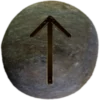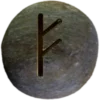Last Updated on March 24, 2025
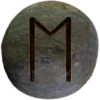
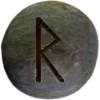
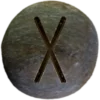
Symbolism and Meaning
Ehwaz (ᛖ) (pronounced “EH-wahz”) represents the e sound in the Elder Futhark. Some alternative spellings include “Ehwas” or “Eihwaz,” though the latter is often associated with another rune. The shape resembles two parallel lines or a mirrored “M.” This rune embodies movement, trust, and partnership.
It represents progress, change, and controlled motion. The rune often symbolizes a horse, a key element of travel and cooperation in ancient societies. Horses enabled mobility, strengthened partnerships, and played vital roles in trade and warfare. The rune conveys steady progress, emphasizing trust between companions or allies.
This rune also signifies balance and harmony. Just as a rider and horse must work together, Ehwaz represents mutual reliance. It suggests unity, making it valuable in relationships, teamwork, and self-improvement. Unlike runes associated with abrupt transformation, Ehwaz promotes gradual and controlled evolution.
Historical and Linguistic Context
The Proto-Germanic root ehwaz means “horse.” The Old Norse word jór carries a similar meaning. Inscriptions and historical texts often associate it with travel, trust, and partnership. Horses were central to early civilizations, symbolizing nobility, power, and survival.
Ehwaz appears in multiple Germanic dialects. The Anglo-Saxon rune poem describes the horse as a noble companion, emphasizing its reliability. This reinforces a connection to movement, dependability, and shared goals.
Uses and Interpretations
Ehwaz appears in contexts related to teamwork, alliances, and journeys. Ancient travelers and warriors may have invoked it for safe passage. The rune also signifies trust, essential in partnerships and personal growth. It embodies progress, urging movement toward goals through cooperation.
Unlike disruptive change, Ehwaz suggests smooth transitions. It represents transformation through experience and learning. Traders, warriors, and settlers relied on steady progress, reinforcing the rune’s significance. It encourages adapting to new circumstances with patience and strategy.
Mentions in Norse Texts
Ehwaz is not explicitly named in the Poetic or Prose Edda, but horses play crucial roles in Norse mythology. Sleipnir, Odin’s eight-legged steed, represents divine travel and speed. This connection strengthens the run’s ties to progress, movement, and transition. ![]()
Horses appear in various sagas as symbols of status, power, and fate. The link between horses and the gods suggests deeper meanings for Ehwaz beyond physical travel. The rune embodies guidance, intention, and controlled advancement toward one’s destiny.
Connection to Daily Life
Ancient societies depended on horses for transportation, trade, and survival. Ehwaz symbolized that reliance, translating into modern interpretations of progress and cooperation. Today, the rune suggests balanced movement, reinforcing trust between individuals working toward a shared goal.
Ehwaz applies to relationships, careers, and self-improvement. It encourages harmony when facing change. Movement should be intentional and steady, rather than reckless. The bond between horse and rider mirrors trust, strategy, and teamwork, essential qualities in personal and professional life.
Many use it as a reminder to embrace change with patience. The rune emphasizes the importance of effort and reliability. Success often depends on consistent progress and strong connections with others. This rune teaches that moving forward requires commitment and shared purpose.
Runes Associated with Ehwaz
Ehwaz connects strongly with the Raido (ᚱ) (“RAY-doe”) and Gebō (ᚷ) (“GEH-boh”) Elder Futhark runes. ![]()
Raido represents journeys, movement, and directed action. Ehwaz, symbolizing the horse, emphasizes cooperation in travel. Together, these runes highlight controlled motion, partnership, and trust. A traveler without direction gains purpose through Raido. A journey without a reliable steed finds strength in Ehwaz.
Gebō signifies gifts, exchanges, and balance. Ehwaz reflects harmony between rider and horse, much like Gebō’s concept of reciprocal bonds. A partnership, whether in travel or trade, thrives on mutual respect. Gebō ensures fairness in exchanges, while Ehwaz reinforces loyalty and synchronization.
These three runes intertwine through movement, trust, and balance. One cannot journey without direction, exchange without fairness, or bond without unity. These runes offer guidance in forging strong connections and navigating life’s paths.
Its Power in Asatru
Asatruar see this rune as a sign of cooperation between people, gods, and spirits. It symbolizes the bond between horse and rider, reflecting harmony and shared purpose.
This rune encourages loyalty and teamwork. It reminds Asatruar to trust in strong relationships and personal growth. Ehwaz also suggests progress, urging people to embrace change with confidence.
In rituals, it strengthens bonds within kindreds and deepens spiritual connections. It serves as a guide for those seeking unity with divine forces. Many use it when pursuing new paths or strengthening alliances. By embracing it, Asatruar honor their commitments and move forward with balance. It reminds them that success comes from trust, action, and cooperation.

